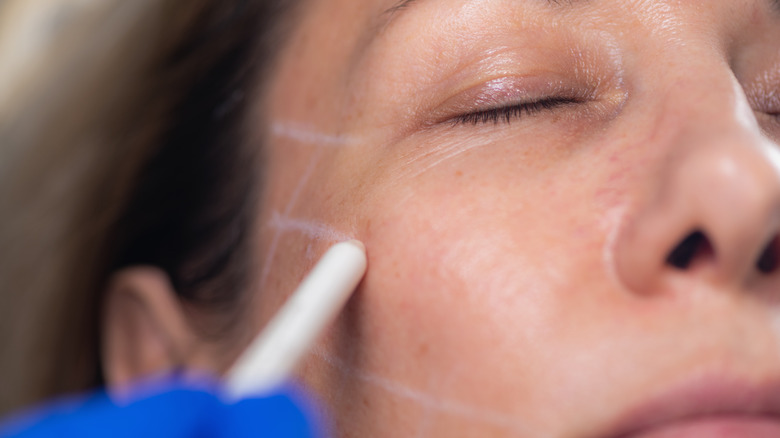What Is Filler Fatigue, And Why Should You Be Worried About It?
Have you ever looked at someone and thought, "Wow, they have gotten A LOT of filler?" This can be marked by bruising, unrealistically robust lips, a face that appears too tight, or the dreaded overinflated "chipmunk cheeks." These are all tell-tell signs of filler fatigue. Though there isn't much scientific data studying this occurrence, experts can spot this condition a mile away, one of the many risks of dermal fillers.
In short, filler fatigue is described as the over-injection of a single spot. Fillers are meant to give you a naturally refreshed look, but injecting too much product can cause an adverse effect. Sadly, as dermal fillers grow in popularity, more cases of filler fatigue are being seen in patients. Advanced facial aesthetics clinician Dr. Nina Bal has seen her share of filler fatigue in all stages, causing different appearances across the face. For example, lips with too much filler tend to have a notable fullness above the lip. "Anatomically, every patient will present differently," Dr. Bal explained to Harper's Bazaar.
While many patients may believe laying off the injections for a while will fix this condition, things could become more severe, so anyone who gets this cosmetic procedure should be concerned about the long-term effects. If you aren't mindful of how much you are getting injected, you could be in for a long road of reconstruction.
Filler fatigue could be a sign that your injector is untrained
Cosmetic dental surgeon and facial expert Dr. Nina Bal raised a serious concern about the practitioners injecting fillers. When conveying her expertise with Harper's Bazaar, she shared that injectors often recommend incorrect procedures for patients. Sometimes, they advise recipients to get fillers to "lift" cheeks or jawlines when this is impossible. Dermal fillers can only contour the region it's injected into. "Patients are having multiple milliliters of dermal filler injected repetitively in the hope of 'lifting' when this is simply not the best treatment option for the patient," Dr. Bal told the publication.
Aside from giving you an unfavorable appearance, the possibility of dealing with an unknowledgeable injector is extremely dangerous. Those who are not well-versed in applying fillers can mistakenly go too deep with the needle and inject the product into a blood vessel. This can lead to necrosis, strokes, or other health conditions, per the FDA.
An unskilled injector can also fail to recognize the signs of filler fatigue. To avoid overtreatment, it's crucial that the patient only gets their fillers reapplied after enough time has passed. Since some fillers can last up to 12 months, a provider should refrain from urging anyone to come in sooner for new shots. If they do, this is another red flag.
Filler fatigue may require dissolving or surgery
Most filler will naturally dissolve into the body, because hyaluronic acid, a natural skin compound, is the main ingredient. Medical intervention is necessary only if filler fatigue has evolved beyond this. Thankfully, dissolving filler is an option. During this process, the enzyme hyaluronidase is used to break down the hyaluronic acid. Depending on the area and how greatly impacted it is, multiple dissolving sessions may be needed. If the filler has migrated away from its intended location, an MRI may be necessary to determine precisely where the product is.
Surgical removal may be the only option if dissolving fails, though this can be incredibly complex. One major factor with the surgical route is the filler being attached to a nerve, as trying to separate the two could result in damage. Since it's often impossible to cut out all the filler during the first surgery, several others may follow. If filler fatigue has caused the face to sag permanently, a different type of procedure can help — a facelift, which works by pulling the skin back, creating a tighter appearance.
No one is discouraging filler lovers from getting their annual poke, but knowing the consequences of over-injecting can save you a world of heartache. As a best practice, avoid frequent jabs and find a highly qualified injector. Pay close attention to the price as well. If it all sounds too good and too cheap to be true, it likely is.


